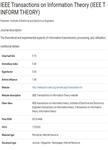版权所有:内蒙古大学图书馆 技术提供:维普资讯• 智图
内蒙古自治区呼和浩特市赛罕区大学西街235号 邮编: 010021

作者机构:Univ Notre Dame Dept Elect Engn Notre Dame IN 46556 USA
出 版 物:《IEEE TRANSACTIONS ON INFORMATION THEORY》 (IEEE Trans. Inf. Theory)
年 卷 期:1998年第44卷第1期
页 面:197-214页
核心收录:
学科分类:0808[工学-电气工程] 08[工学] 0701[理学-数学] 0812[工学-计算机科学与技术(可授工学、理学学位)]
基 金:National Science Foundation NSF (NCR 96-96064)
主 题:channel capacity concatenated codes generalized minimum-distance decoding mutual information
摘 要:This paper analyzes the performance of concatenated coding systems operating over the binary-symmetric channel (BSC) by examining the loss of capacity resulting from each of the processing steps. The techniques described in this paper allow the separate evaluation of codes and decoders and thus the identification of where loss of capacity occurs. They are, moreover, very useful for the overall design of a communications system, e.g., for evaluating the benefits of inner decoders that produce side information. The first two sections of this paper provide a general technique (based on the coset weight distribution of a binary linear code) for calculating the composite capacity of the code and a BSC in isolation. The later sections examine the composite capacities of binary linear codes, the BSC, and various decoders. The composite capacities of the (8,4) extended Hamming, (24, 12) extended Golay, and (48, 24) quadratic residue codes appear as examples throughout the paper. The calculations in these examples show that, in a concatenated coding system, having an inner decoder provide more information than the maximum-likelihood (ML) estimate to an outer decoder is not a computationally efficient technique, unless generalized minimum-distance decoding of an outer code is extremely easy. Specifically, for the (8,4) extended Hamming and (24, 12) extended Golay inner codes, the gains from using any inner decoder providing side information, instead of a strictly ML inner decoder, are shown to be no greater than 0.77 and 0.34 dB, respectively, for a BSC crossover probability of 0.1 or less. However, if computationally efficient generalized minimum-distance decoders for powerful outer codes, e.g., Reed-Solomon codes, become available, they will allow the use of simple inner codes, since both simple and complex inner codes have very similar capacity losses.